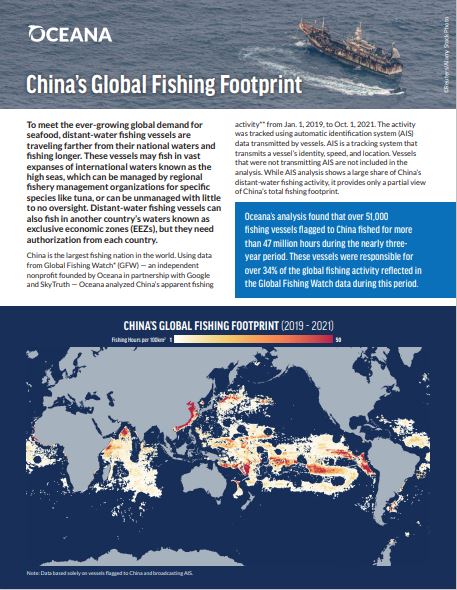December 16, 2021
FAR-REACHING FISHING: The Global Footprint of China’s Distant-Water Fishing Fleet
As the world’s largest and most subsidized fishing fleet, China has a significant effect on ocean ecosystems around the globe. Oceana analyzed China’s fishing* activity worldwide between 2019 and 2021 using data from Global Fishing Watch** (GFW) — an independent nonprofit founded by Oceana in partnership with Google and SkyTruth. The analysis, outlined in a new fact sheet here, sheds light on China’s global fishing footprint, which includes over 51,000 China-flagged fishing vessels. However even this is only a partial view of China’s fishing activities during this time, as it reflects only those vessels flagged to China and transmitting automatic identification system (AIS) data.
Oceana’s analysis provides a snapshot of China’s immense fishing effort, listing the top coastal countries where China fished, the types of vessels that make up the fleet, where the fleet concentrates its fishing activity, and more. Of the 47 million hours of Chinese fishing activity tallied, Oceana found that 10 million were spent outside of the country’s own waters, either fishing on the high seas or in the waters of over 80 other nations. China’s fleet accounted for 30% of all recorded high seas fishing activity and 34% of the global fishing activity captured by GFW data over the three-year period. Paying close attention to fishing activity on the high seas is important because of the challenges with international oversight and complex jurisdictional systems across vast expanses of open water.
This analysis provides a better understanding of the scale of China’s distant-water fishing fleet and demonstrates why transparency is essential to ensure all distant-water fishing is visible to the public eye. Massive distant-water fishing fleets are only able to operate at such a vast scale thanks to harmful government subsidies that drive overcapacity and overfishing. The lack of enforcement of distant water fishing also raises serious concerns about ocean health and the risk of illegal, unreported, and unregulated (IUU) fishing. Oceana is calling on governments like the United States to require expanded transparency and traceability of imported seafood to help verify that it is safe, legally caught, responsibly sourced, and honestly labeled. Read more about Oceana’s campaign here.
READ THE FACT SHEET HERE.
TAKE ACTION HERE.
*Any and all references to “fishing” should be understood in the context of Global Fishing Watch’s (GFW) fishing detection algorithm, which is a best effort to determine “apparent fishing effort” based on vessel speed and direction data from the automatic identification system (AIS) collected via satellites and terrestrial receivers. As AIS data varies in completeness, accuracy, and quality, and the fishing detection algorithm is a statistical estimate of apparent fishing activity, it is possible that some fishing effort is not identified and, conversely, that some fishing effort identified is not fishing. For these reasons, GFW qualifies all designations of vessel fishing effort, including synonyms of the term “fishing effort,” such as “fishing” or “fishing activity,” as “apparent” rather than certain. Any/all GFW information about “apparent fishing effort” should be considered an estimate and must be relied upon solely at your own risk. GFW is taking steps to make sure fishing effort designations are as accurate as possible.
**Global Fishing Watch, a provider of open data for use in this analysis, is an international nonprofit organization dedicated to advancing ocean governance through increased transparency of human activity at sea. The views and opinions expressed in this blog and fact sheet are those of the authors, which are not connected with or sponsored, endorsed or granted official status by Global Fishing Watch. By creating and publicly sharing map visualizations, data and analysis tools, Global Fishing Watch aims to enable scientific research and transform the way our ocean is managed. Global Fishing Watch’s public data was used in the production of this fact sheet.
MOST RECENT
September 3, 2025
Air Raid Panic to Informed Skies and Seas: The National Weather Service in a Nutshell
August 29, 2025
August 22, 2025
Corals, Community, and Celebration: Oceana Goes to Salmonfest!




